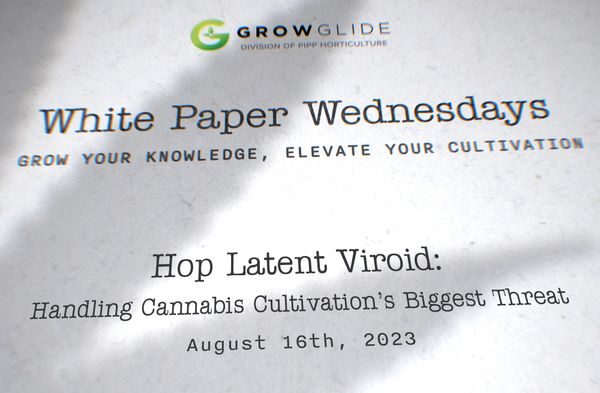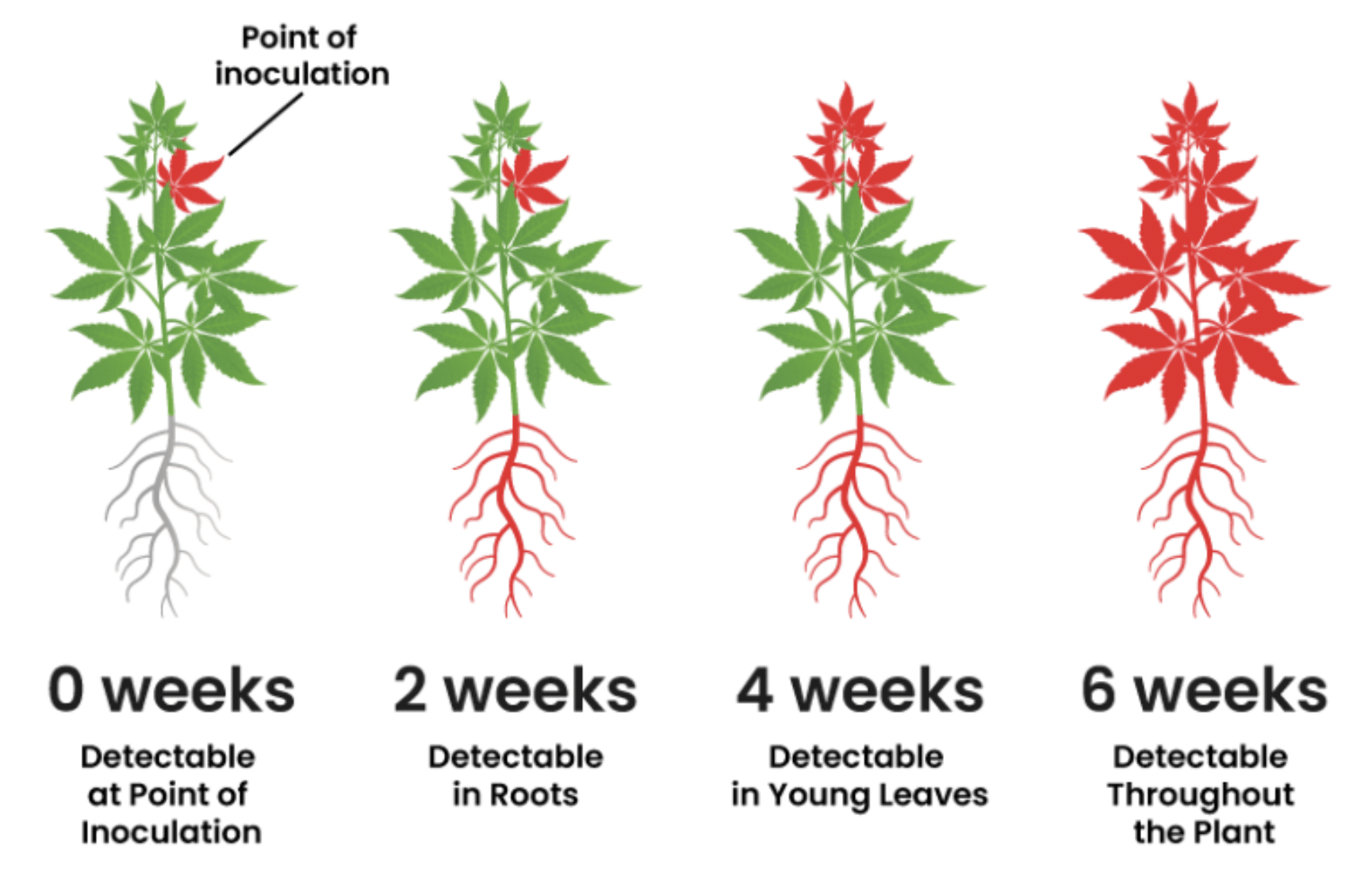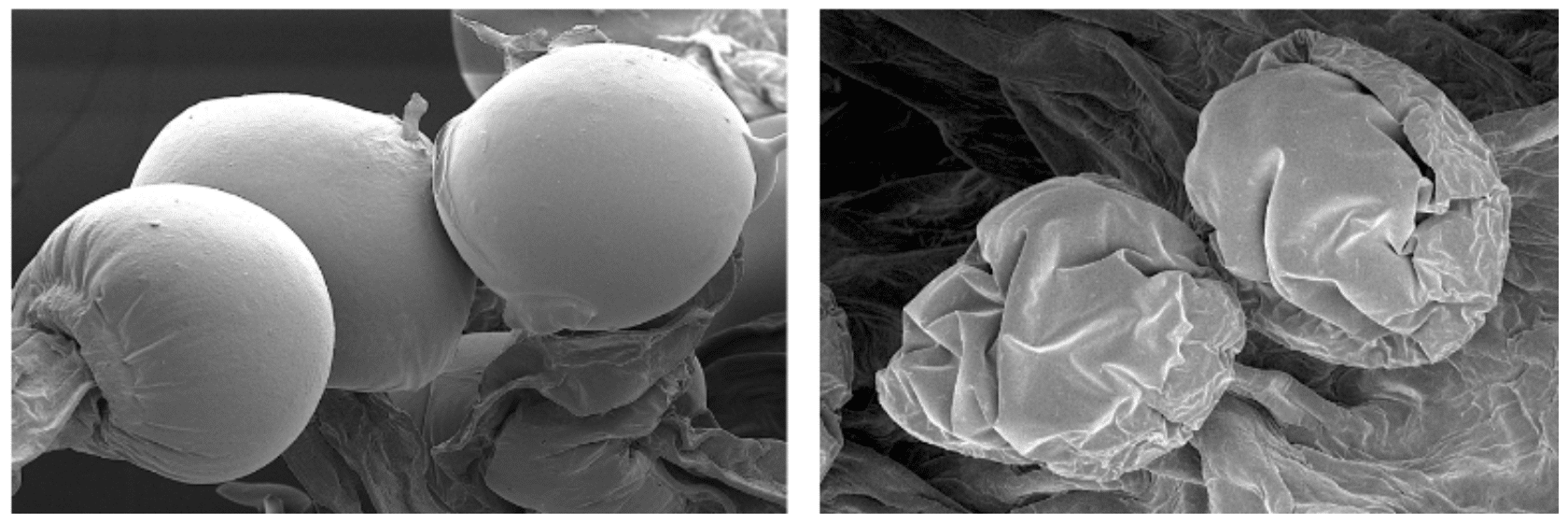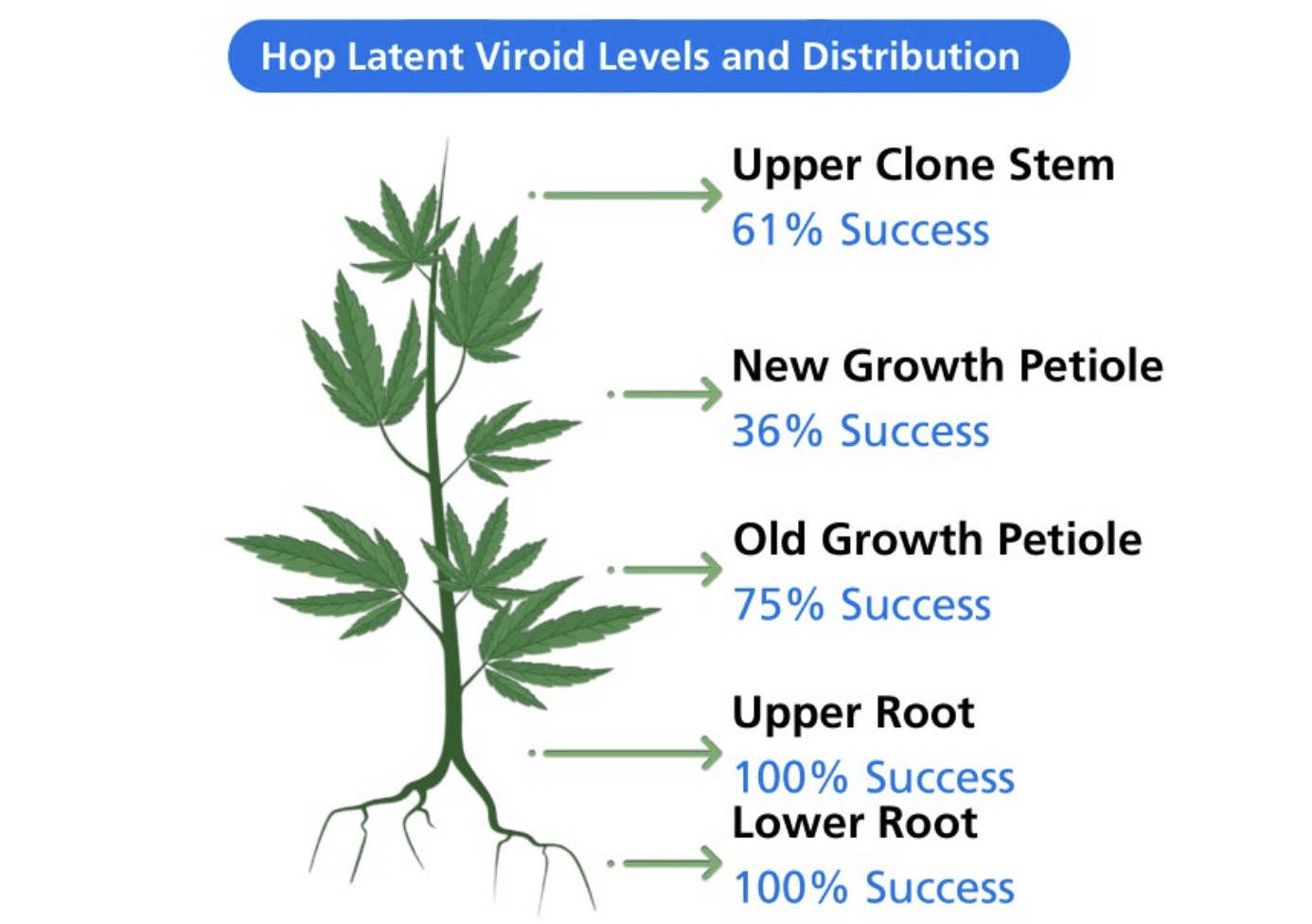
Cannabis cultivation has experienced significant growth over the past decade. However, as the industry matures, it has encountered various challenges, one of which is the threat of diseases caused by pathogens like the Hop Latent Viroid (HLVd).
According to a recent study, HLVd has become the most destructive cannabis disease in cannabis-growing areas, leading to substantial losses in yield and quality. As growers strive to produce top-tier cannabis, understanding and managing the impact of HLVd is paramount. This week’s White Paper Wednesday delves into the intricacies of HLVd, its transmission modes, detection methods, and effective management strategies, offering critical insights to cultivators seeking to mitigate its detrimental effects.
What is HLVd?
Hop latent viroid (HLVd) is a small infectious RNA molecule that affects hop plants (Humulus lupulus), which are primarily cultivated for use in brewing beer. It belongs to the family Avsunviroidae and is considered a viroid, which is a pathogen that consists solely of a circular, single-stranded RNA molecule without a protein coat.
HLVd was first identified in the 1970s and has since been found in hop-growing regions worldwide. It is known to cause several symptoms and diseases collectively referred to as hop stunt and hop latent viroid disease. The viroid can infect hop plants without causing any noticeable symptoms, leading to latent infections. However, under certain conditions, such as stress or co-infection with other pathogens, the viroid can become active and lead to disease development.
Symptoms of hop latent viroid disease may include stunted growth, reduced yield, poor flower quality, leaf discoloration, and dudding or rapid plant death.
The Impact on Cannabis Cultivation
The burgeoning cannabis industry, known for its rapid evolution and innovation, has been significantly impacted by the prevalence of HLVd. A recent survey conducted by Tumi unveiled a concerning figure: 73% of cannabis cultivation facilities worldwide are affected by this viroid. Shockingly, in the United States, the average HpLVd infection rate stands at 30%, with places like California reporting a staggering up to 90% of grows testing positive for HpLVd in their facilities. This is a daunting statistic for an industry that is still in its formative years.
From a financial perspective, the ramifications are severe. The 73% prevalence rate translates to an estimated $4 billion in annual losses, resulting from decreased crop yields and the costs of detection, management, and eradication of the viroid from cultivation facilities. Further exacerbating these losses, HpLVd’s impact on cannabis flower can lead to a substantial 30% to 50% reduction in cannabinoid content. Consequently, infected plants often produce buds of compromised quality, which can significantly diminish the market value of the yield.
Looking more broadly, the impact of HLVd can potentially slow down the pace of research and innovation in the cannabis industry. As growers and researchers dedicate more resources to combating this viroid, they might have fewer resources to invest in developing new resistant cultivars, refining cultivation techniques, or exploring the myriad of potential medical applications of cannabis.
While HLVd might seem like just another challenge for cannabis growers, its wide-reaching implications touch upon the financial, operational, reputational, and regulatory facets of the industry, potentially shaping its trajectory for years to come.
HLVd Transmission
The transmission of HLVd in cannabis can occur through various means, but one thing remains the same; once a plant is infected, the viroid can spread systemically throughout the plant, infecting different tissues and organs.
According to Cannabis Industry Journal, there are several means of transmission:
Mechanical Transmission: HLVd often spreads by directly coming into contact with contaminated sap, especially during activities like trimming and manipulation. The spread through contaminated water is also documented. Additionally, there’s evidence to suggest that insects, seeds, and fungi contribute to the distribution of HLVd.
Seed Transmission: While there is a lack of published research on the transmission rate of HLVd in cannabis seeds, it’s established that about 8% of seeds will transmit HLVd. Preliminary investigations by TUMI Genomics and EZ-genetics point out that the transmission rates in cannabis seeds may fluctuate depending on the cultivar and the infection degree of the originating plants.
Water Transmission: Studies have highlighted that viroids are notably concentrated in plant roots and can migrate to the water through runoff. Plants that utilize the same water source as infected ones, notably in setups like water recirculation or flood and drain systems, could be vulnerable to viroid infections.
Insect and Other Vector Transmission: While it’s still uncertain whether insects play a direct role in transmitting HLVd, many viroids are known to spread via insect vectors. This suggests a plausible risk for HLVd transmission in the same way. Additionally, recent findings hint that certain fungal pathogens, including Fusarium, might play a role in viroid transmissions. Given that these fungi are a concern for cannabis growers, managing their presence could potentially mitigate the risk of hop latent viroid transmission.
(Medicinal Genomics, 2023)
Strategies for Early Detection
Several diagnostic methods have been developed to detect HLVd:
PCR (Polymerase Chain Reaction) Testing: PCR is a highly sensitive and accurate method for detecting HLVd in cannabis. This technique amplifies the viroid’s genetic material, making it easier to identify and quantify. $50-200/sample
ELISA (Enzyme-Linked Immunosorbent Assay) Testing: ELISA is an antibody-based test that detects the presence of HLVd proteins. It is a widely used method for screening large quantities of samples quickly. $20-150/sample
Loop-Mediated Isothermal Amplification (LAMP) Testing: LAMP is a molecular biology technique that amplifies DNA or RNA at a constant temperature. It is a rapid and cost-effective method for HLVd detection. $30-$100/sample
Next-Generation Sequencing (NGS) Testing: NGS is a high-throughput method that can identify and sequence the entire genome of HLVd. It provides detailed information about the viroid’s genetic makeup and any potential mutations. $100- $1000+/sample
Visual Inspection: While not as reliable as the above methods, visual inspection can sometimes reveal symptoms of HLVd infection, such as stunted growth, yellowing leaves, and distorted flowers. However, this method should be complemented by laboratory testing for accurate diagnosis.
(Medicinal Genomics, 2023)
HLVd and other viroids can only be detected through molecular testing, which identifies the presence of DNA/RNA. The PCR test is often deemed the most accurate and sensitive of these techniques. Beyond diagnosis, PCR can also gauge the amount of viroid present, facilitating informed management decisions. Although alternative molecular tests, such as LAMP and RPA, have the potential to be as sensitive as PCR, they tend to yield inaccurate results, thereby affecting their reliability.
Additionally, selecting the appropriate plant tissue for HLVd detection is vital, especially when trying to detect early or low-intensity infections before HLVd becomes widespread within the plant. The root tissue typically holds the highest concentrations and is the first location to show indication of infection but as ithe roots are underground they are often overlooked. This leads to rapid spread of HLVd through shared water until leaves and above ground growth start to show symptoms and require testing . . . which is often too late.
Managing HLVd: Best Practices to Follow
One of the challenges with HLVd is that it can remain latent within the plant, meaning that infected plants may not display any symptoms for a significant period. This latency makes it difficult to detect and control the spread of the viroid. Moreover, HLVd can be transmitted vertically, passing from infected mother plants to their offspring through seeds, further contributing to its persistence.
(Saldi, 2023)
What does that mean when it comes to managing HLVd? It means cultivators need to take a multi-faceted approach:
Sanitation: Regular sterilization of tools and equipment, especially those used for pruning or trimming, is essential as HLVd can remain infectious on tools for up to eight days. Using a 10% bleach solution to clean gloves and tools, can significantly reduce transmission risks (heat and alcohol are not effective in killing the viroid).
Quarantine: Isolating new plants or cuttings for a period and closely monitoring them for any symptoms can help prevent the introduction of HLVd into a cannabis cultivation facility.
Testing and Monitoring: Regular testing of plants for HLVd can aid in early detection and the implementation of appropriate control measures.
Plant Breeding: While currently there aren’t any HLVd-resistant cannabis cultivars, future research might pivot in this direction, aiming for strains that naturally resist the viroid.
Personal Protective Measures: Individuals handling plants should wear protective clothing and gloves. Given that HLVd can remain infectious on human skin for about three hours, and over 24 hours on materials like cotton and leather, strict adherence to hygiene standards is pivotal.
It’s worth noting that the specific regulations and guidelines for managing HLVd may vary depending on the region or country. Therefore, it is essential for growers to consult local agricultural authorities or experts for up-to-date information and guidance on preventing and managing HLVd in cannabis.
Looking Forward
The cannabis industry, though burgeoning, is not without its challenges. HLVd represents a significant hurdle for growers, demanding comprehensive strategies for detection and management. However, with continued research and adherence to best practices, we’re hopeful the industry can curb the viroid’s impact and secure healthier, more bountiful yields for cultivators everywhere.
Adkar-Purushothama, C. R., Shimmen, T., & Perreault, J. (2023). HoP latent viroid: a hidden threat to the cannabis industry. Viruses, 15(3), 681. https://doi.org/10.3390/v15030681
FAQs — TUMI Genomics. (n.d.). TUMI Genomics. https://tumigenomics.com/faqs
HOP Latent viroid (HPLVD): What we know — E T H O s. (n.d.). https://www.ethosgenetics.com/resources/hop-latent-viroid-hplvd-what-we-know
Medicinal Genomics. (2023, June 16). HoP latent viroid in cannabis | Medicinal Genomics – Medicinal Genomics. https://medicinalgenomics.com/hop-latent-viroid-in-cannabis/
Lange, T. (2023, June 8). 4 Methods of Spread for Hop Latent Viroid: What Every Cultivator Should Know About This ‘Silent Killer.’ Cannabis Business Times. https://www.cannabisbusinesstimes.com/news/hop-latent-viroid-spread-zamir-punja/
Saldi, T., PhD. (2023, July 6). HOP Latent Viroid (HLVD) & Pathogen Diagnostics: A Comprehensive Overview. Cannabis Industry Journal. https://cannabisindustryjournal.com/feature_article/hop-latent-viroid-hlvd-pathogen-diagnostics-a-comprehensive-overview/















